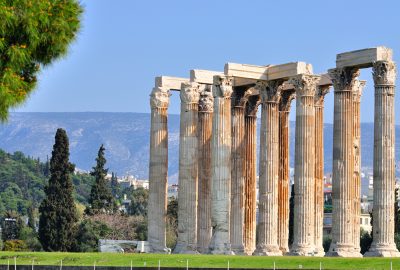Athens, the oldest city in Europe, the cradle of diplomacy, the seat of philosophy, culture and so much more. The modern world would not be the same without Greece and Athens. Even their mythology is so widely known that we read it in elementary school even before the Bible, which demonstrates how significant and valuable it is compared to “the other book”. Athens is the largest Greek city, and still it only has around 650,000 inhabitants, while the whole metropolitan area has 3.75 million. But it makes up to these digits with incoming tourists; an incredible number of 3,5 million people visit the capital every single year. When we calculate the all the other destinations like the islands each year then the total number of foreigners coming to Greece add up to more than 22 million people. It demonstrates how important tourism is to the Hellenic Republic.

Even with the remaining 15 columns (originally 104) you can imagine how huge was the Temple of Olympian Zeus in Athens
Athens is probably not the best city to visit in summer when the high temperatures and city smog can become unbearable. But the city should definitely be on the list of every traveller. From the iconic Acropolis and its Parthenon to the pedestrian-only promenade in the ancient city centre, which is one of the longest in Europe. Athens can rival with the eternal city Rome and all other world-famous cities. Remember the great financial crisis? It seems the Greeks are slowly but surely getting over it. The country is shaking it off like and it is starting to flourish again. Foreigners, especially the Chinese businessmen but also local entrepreneurs are investing again into tourism and infrastructure.
No matter how much time you have, a visit of Athens will not be complete without seeing the archaeological site of the Acropolis, which is the most important ancient Greek monument of the entire world. Yes, you can see especially the Parthenon from almost every location in Athens since it is towering over the city and especially at nights when the monuments are illuminated, it is a magnificent picture. But I am sorry: it does not fully count and you will need to see it for yourself. So move your lazy ass and go up although it might be a tiresome climb, especially on hot summer days. Acropolis means “upper city” and this is where people lived 5000 B.C and where they felt better protected against the continuing attacks by enemies. It is regarded as the birthplace of democracy, and it paid the path for modern civilizations. You will enter the site through Beule Gate and then pass through the Propylaia entrance where you can already check out the Temple of Athena Nike.
Without any doubts the most photographed monument at the Acropolis is the Parthenon, which means “apartment of the Virgin” and was erected to honour the goddess Athena the virgin who gave the city all of its wealth. Go also seeing the Odeon of Herodus Atticus, ancient theatre built in the Roman Times, which is functioning already for 2,000 years as a theatre for music and many other performances. Allow yourself also some time for visiting the Acropolis Museum; its large glass panes and walkways will offer you amazing panoramic views to old and modern Athens.

The grand Erechteion in Acropolis built on the place of the legendary dispute between Poseidon and Athene
Also the downtown of Athens centre has some famous ancient sights such as the Temple of Zeus, also known as the Olympeion, built to honour the father of all Gods. And there is of course the famous Arch of Hadrian, a triumphal arch to glorify the Roman Emperor Hadrian. The Agora, which translates as “gathering place” is less invaded by huge hordes of tourists than the Acropolis. But it can grant the same mind-blowing experience of travelling back to the ancient Greek times. This was once the buzzing commercial, political and intellectual epicentre of Athens, filled to the brim with shops, markets and schools. Close your eyes and imagine you hear Socrates teaching again his wisdom to young students.
So far, so good for ancient Athens. When you are hungry and thirsty and fed up with ruins, Corinthian pillars and Gods, you definitely need to indulge yourself into Athens’ vibrant restaurants and nightlife scene. Head to Plaka, the atmospheric area in downtown Athens that genuinely feels like a village within the city. It is now mainly a pedestrian zone and filled to the brim with restaurants and bars. According to local partygoers it has lost a bit of its attraction when the local authorities decided to close down many night clubs in Plaka because they played too loud music and also you could come across some tourist traps. For a different, more edgy atmosphere you could alternatively visit Gazi, which has become the new hot spot in town. It is very popular with the local hipsters and alternative crowds. It’s a bit out of the city centre but can be easily reached with metro line 3. Nevertheless, Plaka is still a very good place to spend the evening and you can always go clubbing later on since the city literally never sleeps. Sit down in one of those charming taverns in Plaka, order some of those delicious famous Greek tapas called meze and let it be accompanied by a glass of wine or some stronger local liquids. Jamas!



No one commented yet. Be the first.